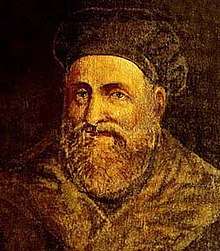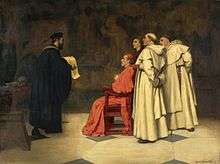Gabriele Falloppio
Gabriele Falloppio (1523 – October 9, 1562) was an Italian Catholic priest and anatomist often known by his Latin name Fallopius. He was one of the most important anatomists and physicians of the sixteenth century.
Gabriele Falloppio | |
|---|---|
 Gabriele Falloppio | |
| Born | 1523 |
| Died | October 9, 1562 |
| Nationality | Italian |
| Alma mater | Ferrara |
| Known for | Medicine |
| Scientific career | |
| Fields | Anatomy Medicine |
| Institutions | University of Pisa University of Padua |
| Doctoral advisor | Antonio Musa Brassavola |
| Doctoral students | Girolamo Fabrici Volcher Coiter |
Early life
He was born in Modena and died in Padua. His family was noble but very poor and it was only by a hard struggle he succeeded in obtaining an education. Financial difficulties led him to join the clergy, and in 1542, he became a canon at Modena's cathedral. He studied medicine at the University of Ferrara, at that time one of the best medical schools in Europe. He received his MD in 1548 under the guidance of Antonio Musa Brassavola. After taking his degree he worked at various medical schools and then became professor of anatomy at Ferrara, in 1548. Girolamo Fabrici was one of his famous students. He was called the next year to the University of Pisa, then the most important university in Italy. In 1551 Falloppio was invited to occupy the chair of anatomy and surgery at the University of Padua. He also held the professorship of botany and was superintendent of the botanical gardens. Though he died when less than forty, he had made his mark on anatomy for all time.
Medical contributions

Falloppio's own work dealt mainly with the anatomy of the head. He added much to what was known before about the internal ear and described in detail the tympanum and its relations to the osseous ring in which it is situated. He also described minutely the circular and oval windows (fenestræ) and their communication with the vestibule and cochlea. He was the first to point out the connection between the mastoid cells and the middle ear. His description of the lacrimal ducts in the eye was a marked advance on those of his predecessors and he also gave a detailed account of the ethmoid bone and its cells in the nose. His contributions to the anatomy of the bones and muscles were very valuable. It was in myology particularly that he corrected Vesalius. He studied the reproductive organs in both sexes, and described the Fallopian tube, which leads from the ovary to the uterus and bears his name to this day.
The aquæductus Fallopii, the canal through which the facial nerve passes after leaving the auditory nerve, is also named after him. Falloppio’s contributions to neuroanatomy, however, are still of interest today due to attempts to better understand the structures he first found. He was interested in the sensory systems in the face. He centered his research on understanding the path of the nerves of the face and structures that lie in their tracks. Here, he left his name to two parts of the human face, only emphasizing his enormous influence on the study of the head. The facial canal was first described by Falloppio, who studied its path, structure, and contents. He also described the Fallopian hiatus, an opening in the anterosuperior part of the petrosal bone.[1]
His contributions to practical medicine were also important. He was the first to use an aural speculum for the diagnosis and treatment of diseases of the ear, and his writings on surgical subjects are still of interest. He published two treatises on ulcers and tumors, a treatise on surgery, and a commentary on Hippocrates's book on wounds of the head. In his own time he was regarded as somewhat of an authority in the field of sexuality. Fallopio was the first to describe a condom (in his writings, a linen sheath wrapped around the penis), and he advocated the use of such sheaths to prevent syphilis. In an early example of a clinical trial, Falloppio reported that he tested these condoms in 1,100 men, none of whom contracted syphilis.[2][3] Falloppio was also interested in every form of therapeutics. He wrote a treatise on baths and thermal waters, another on simple purgatives, and a third on the composition of drugs. None of these works, except his Anatomy (Venice, 1561), were published during his lifetime. As we have them, they consist of manuscripts of his lectures and notes of his students. They were published by Volcher Coiter (Nuremberg, 1575).
Falloppio argued against Fracastoro's theory of fossils, as described as follows in Charles Lyell's Principles of Geology:
Falloppio of Padua conceived that petrified shells had been generated by fermentation in the spots where they were found, or that they had in some cases acquired their form from 'the tumultuous movements of terrestrial exhalations.' Although a celebrated professor of anatomy, he taught that certain tusks of elephants dug up in his time at Puglia were mere earthy concretions, and, consistently with these principles, he even went so far as to consider it not improbable, that the vases of Monte Testaceo at Rome were natural impressions stamped in the soil.[4]
Legacy
This was the golden age of anatomy and Falloppio's contemporaries included such great anatomists as Vesalius, Eustachius, and Realdo Colombo (whom he succeeded at Padua). It has sometimes been asserted that he was jealous of certain of the great discoverers in anatomy and that this is the reason for his frequent criticisms and corrections of their work. However, Heinrich Häser, an authority in the history of medicine, declared that Falloppio was noted for his modesty and deference to his fellow workers and especially to Vesalius. His purpose in suggesting corrections, therefore, was the advance of the science of anatomy.
Works
- Kunstbuch Des hocherfarnen und weytberhümpten Herrn Gabrielis Fallopij, der Artzney Doctorn von mancherley nutzlichen Künsten . Sampt einem andern büchlin / durch Christophorum Landrinum außgangen. Manger, Augspurg 1578 Digital edition by the University and State Library Düsseldorf
- Gabrielis Fallopii Wunderlicher menschlichem Leben gewisser und sehr nutzlicher Secreten drey Bücher : vom Authore selbst in Ttalienischer Sprach publicirt, jetzund aber Teutscher Nation zu gutem in unser Muttersprach ubersetzet . Iennis / N. Hoffmann, Franckfurt am Mayn 1616 Digital edition by the University and State Library Düsseldorf
- Omnia, quæ adhuc extant opera (1584)
Anatomical names
Various anatomical structures are named after Falloppio, including Fallopian tube, Fallopian Canal, and Fallopian ligament.
See also
- List of Roman Catholic scientist-clerics
References
- Mortazavi MM, Adeeb N, Latif B, et al. (June 2013). "Gabriele Falloppio (1523–1562) and his contributions to the development of medicine and anatomy". Child's Nervous System. 29 (6): 877–80. doi:10.1007/s00381-012-1921-7. PMID 22965774.
- Potts, Malcolm (1999-02-14). Ever Since Adam and Eve: The Evolution of Human Sexuality. Cambridge University Press. p. 253. ISBN 9780521644044.
Gabriele Falloppio condom.
- Youssef H (April 1993). "The history of the condom". Journal of the Royal Society of Medicine. 86 (4): 226–8. PMC 1293956. PMID 7802734.
- Charles Lyell, Principles of Geology, 1832, p.29
